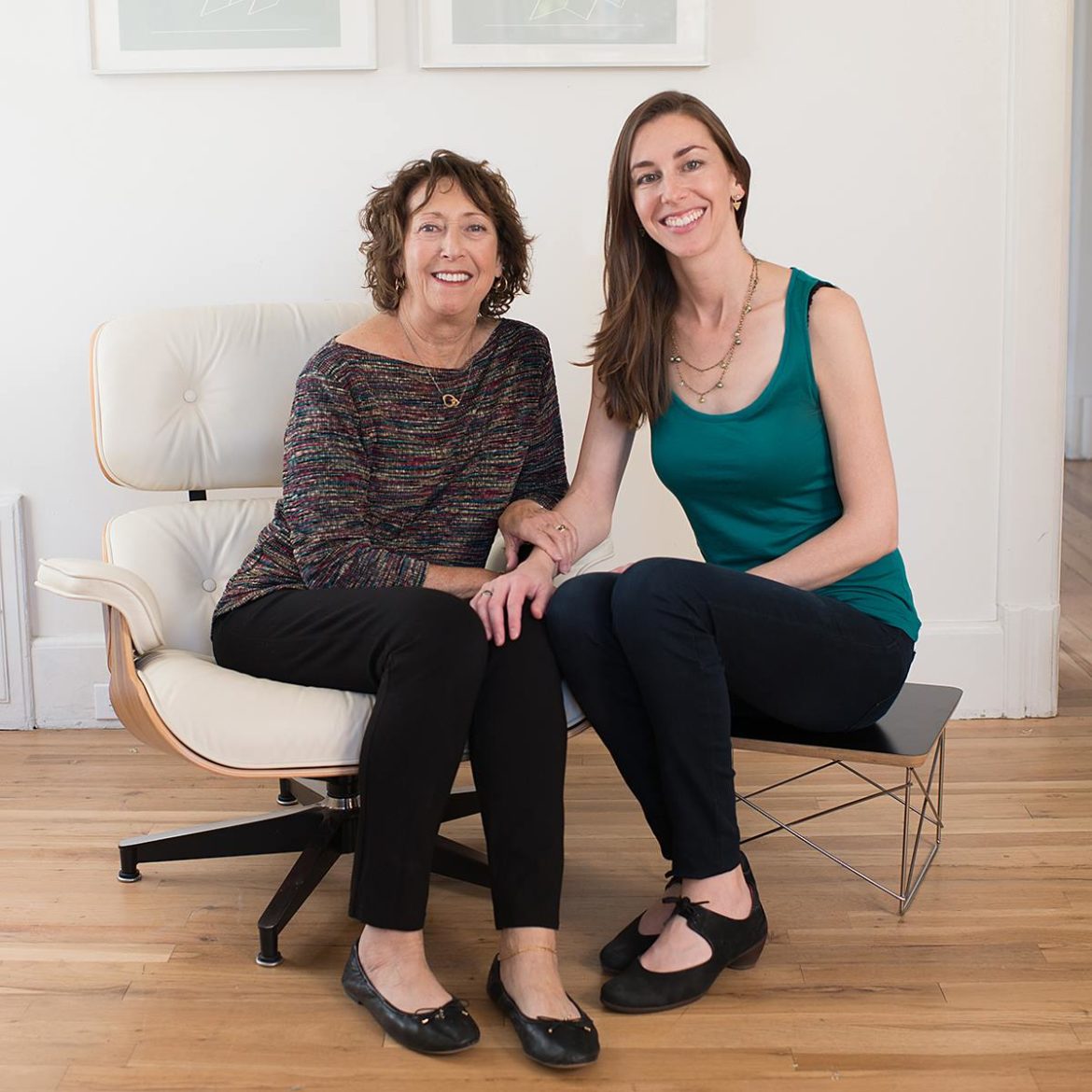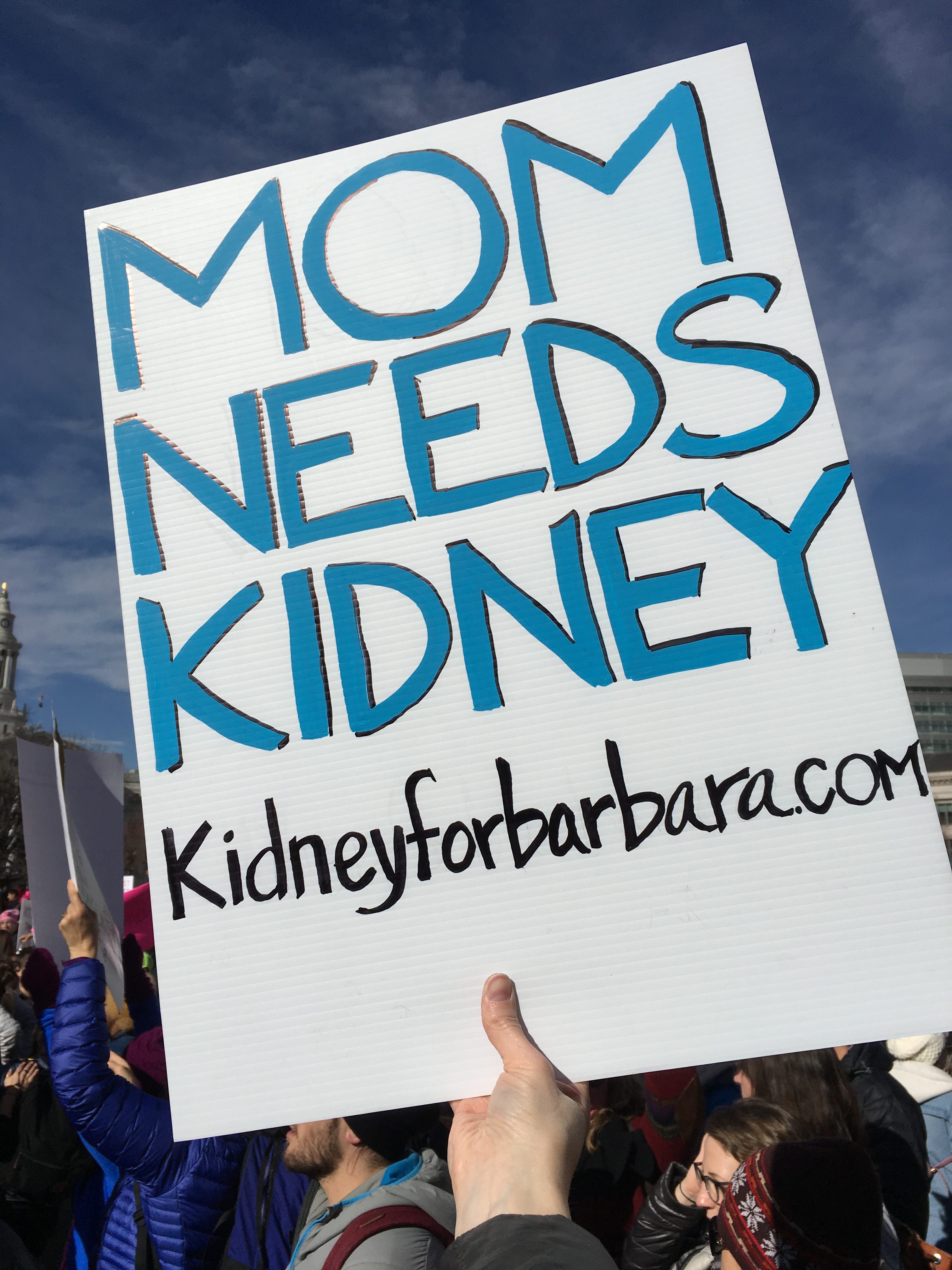On January 20, thousands of people in Denver marched for women’s health, rights and equality. Some marched for immigration and DACA, while others for inclusiveness and diversity. Whatever the reason, women and men came to march for what they believed in and for the change they wanted to affect. For another woman in the crowd that day, she marched for an entirely different reason: her mom’s kidney.
The Problem
Marlow Hoffman walked around the Civic Center holding a sign that read “Share Your Spare. My mom needs a kidney.” Hoffman’s mom, Barbara Hoffman, has struggled with kidney issues for the past 38 years. “I was hospitalized during my pregnancy with Marlow and had to have a cesarian section and early delivery—not because she was in trouble, but because my kidneys were compromised,” recalled Barbara. In 2009, Barbara was diagnosed with septicemia — a bloodstream infection caused by a bacterial infection elsewhere in the body that then enters the blood. In 2013, her name was added to the national transplant list and by 2015, she began peritoneal dialysis.

Peritoneal dialysis (PD) is intended to replace as many functions of the failing kidney as possible but ultimately can’t treat or cure the kidney disease. More than 661,000 Americans have kidney failure. Of these, 468,000 individuals are on dialysis and roughly 115,012 people are on the transplant list. Life expectancy on dialysis varies, but the average is five to 10 years. “Dialysis is something that I’m grateful for in the sense that it is keeping my mom alive right now,” said Marlow. “Without it, she would be dead. So in that respect, it’s a really great thing but it’s a band-aid at best. It’s a short-term, high cost, temporary solution.”
Dialysis may be a short-term solution, but it takes a heavy toll on Barbara’s mental and physical energy. “I’m on dialysis about 10-and-a-half hours a night, so I have to fit that into my schedule,” said Barbara. “I can’t go to sleep late and wake up early because I have to get the full time in. There are a lot of protocols I have to follow when setting up and disconnecting to ensure that I don’t get infections, and there’s a lot of washing and sanitizing. There’s just a lot to do. And, if I travel, I have to take this big machine with me…I’m tired all the time. I have no energy or appetite, and I can’t do the things I used to do.”
When Marlow and her sister were rejected as potential kidney donors, she decided to take matters into her own hands. She launched the website, kidneyforbarbara.com, which provides information on her mom, Barbara, how to be a potential donor for her, facts about kidney disease and donor statistics as well as common questions associated with being a kidney donor. Marlow is quick to point out that being a kidney donor isn’t as scary — or as simple as signing up to donate — as some may think it is.
The Bionic Kidney

To begin, there are several tests to pass to just get your name on the potential candidate list. “You are asked a lot of questions over the phone about your health history, your family’s health history…it’s a completely confidential non-commital five-minute call to just get acquainted and see if you’re even eligible,” said Marlow. “Most people are ruled out over the phone. You could be ruled out for any number of health reasons. They want to make sure that you truly are comfortable with that decision; they don’t want you to be doing something that you’re feeling pressured into.”
In addition to searching for a kidney donor, Marlow also started a CrowdFund for The Bionic Kidney Campaign. “The Bionic Kidney Campaign funds UCSF research going towards a bioartificial kidney that could end the need for dialysis and end the need for donor kidneys. And donor kidneys are in really short supply,” said Hoffman.
The concept behind a bionic kidney is that it’s a small device surgically implanted to help treat end-stage renal disease (ESRD). This will ultimately eliminate the need for donor organs, which are in short supply, and will end the need for dialysis. “They have just started in human testing and they believe they can reach the final stages of regulatory approval starting in 2020,” said Marlow. “They’re on an FDA fast track to get this device out and into the world but it costs money to do all these tests. And so they anticipate needing three million dollars a year to make that happen. And that’s how I got to my $3,000,000 for the bionic kidney campaign.” The goal for the CrowdFund is to raise the $3 million needed for the research. Donations allow them to hire more personnel, expedite their ordering and purchase additional equipment. In short, more funds allow the project to work at a faster pace.
“It’s amazing to think that everyone who needs a kidney could have this device without needing to go through dialysis,” said Barbara. “It will significantly change people’s quality of life for the better. People won’t die waiting; people’s families won’t have to see their loved ones go through this. And, people like Marlow won’t have to work so hard trying to find a solution for their loved ones. I hope it becomes a reality.”
Even though she’s only raised approximately $18,500, Marlow remains positive. “If everyone knows about [the campaign] and if everyone gives something like, $25, and passes it along to their networks and sends an e-mail and just says ‘hey, this is really important and this is something that you can actually play a true role in’ this could raise the money.”
This is also why Marlow used the women’s march as her platform to spread the word and gain awareness. “I knew there would be thousands of people and I needed a way to let people know about this faster because it is a numbers game,” said Marlow. “You never know who’s going to feel inspired to get tested. That means that you have to get your story out in front of as many people as possible. I feel like I’ve been on this quest; it’s time to talk to people face-to-face and say, ‘Listen—this is what’s going on. Share it with people, tell people I’m telling you. Maybe you want to help, and if you don’t, you probably know someone who would be interested in helping. Let’s do this together as a community, and save Barbara’s life.‘ ”

The Bionic Kidney Campaign has a fast-approaching deadline — February 15 at 8 p.m. — and whether or not Barabra is able to receive a bionic kidney, Marlow wants to make it clear she’s also doing this for the countless other families who are going through the same thing. “I want it to be so those future patients — the millions of people who need a kidney — don’t have to go through what my family is going through. That’s why I started the Bionic Kidney Campaign… The promise of the bionic kidney is that when you have it or when patients in the future have it, there won’t be a rejection rate and they won’t have to take any medicine.”
“I’m overwhelmed by [Marlow] as well as the time and energy she’s put into finding a permanent cure with the Bionic Kidney Campaign and finding a living donor for me,” said Barbara. “I also feel like this isn’t part of the bargain: I’m supposed to take care of my children; they’re not supposed to take care of me.”
And while giving any donation will help the goal, there’s nothing like giving a kidney to someone who needs it. Marlow states that if you do make it past the tests and are accepted as a donor, the procedure itself is again, safer — and easier — than most people think. “Giving a kidney, while it is a major surgery, is considered a very safe procedure. Most people do everything they ever did before they got the surgery, if not more. People run marathons, they travel, they do their jobs, they do everything they would have done had they not given a kidney. You only need one kidney.”
There are a number of ways that people can help. One way is to just call and see if you could be a good match, you can donate money to the Bionic Kidney Campaign and then, simply put, you can share this information. “Whether it’s sharing the campaign itself specifically or sharing my mom’s story. Two years from now, there could be a report about how there is now this bioartificial kidney that is saving millions of lives and you could think to yourself, ‘Hey I played a role that helped save those millions of lives.’ You never know who’s going to feel truly inspired to get tested. Some people realize that that’s what they are here for; to save that person’s life.”
For more information on Barbara’s campaign, the Bionic Kidney Campaign or donating a kidney, visit www.kidneyforbarbara.com




